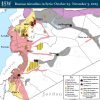Original version in Spanish: Evolución reciente del terrorismo en el Magreb
Theme
While Libya has seen an extraordinary rise in terrorist violence, particularly since 2012, the frequency of attacks has been contained in Algeria since 2013, the year when terrorism started to grow considerably in Tunisia. Morocco has been notorious for an absence of attacks since 2011.1
Summary
The number of terrorist attacks in the Maghreb has increased extraordinarily overt recent years. It is unlikely that their current frequency will lessen in the short term. The main scenario for such attacks is no longer Algeria but Libya. The acts of terrorism are being carried out above all by jihadist groups connected to al-Qaeda and, since 2014, followers of the Islamic State (IS). Their modalities are typical of terrorism and their targets are governmental as well as civilian. It is a terrorist phenomenon characterised by high and increasing frequency but relatively low lethality, although attacks have been recorded every year that have claimed numerous lives. In 2011, acts of terrorism in Maghreb countries accounted for 0.33% of all such incidents throughout the world; in 2014 they accounted for 4.7%.
Analysis
Over the course of 2015, the Maghreb has seen a number of particularly important terrorist acts. Prominent among these were the two consecutive attacks that caused the deaths, on 18 July, of 14 Algerian soldiers in the demarcation of Ain Defla, to the southwest of Algiers; those that claimed the lives of 18 people around the Bardo Museum, in the capital of Tunisia, on 18 March, and, on 26 June, another 38 lives in the tourist resort of Sousse; also the decapitation of 21 Egyptian Christians at an unknown location on the coast of Libya, which came to light in February; and, in the same country, the suicide attacks causing no fewer than 17 deaths in Benghazi on 25 March.
These acts of terrorism are but the most recent expression of a phenomenon that has manifestly been trending upwards in the whole of North African region since 2011, when the anti-government revolts began in Tunisia and Libya, albeit with very different political impacts. Revolts that as such did extend to Morocco and Algeria. The present analysis, based on data elaborated from information contained in the Global Terrorism Database (GTD) of the National Consortium for the Study of Terrorism and Responses to Terrorism (START) at the University of Maryland, explores the evolution of terrorism in the Maghreb between 2011 and 2014, paying special focus to its incidence in the different countries, the modalities adopted in carrying out that violence, the preferred targets and the fatalities caused.
Changes in the terrorism scenario
“The main scenario for terrorism in the Maghreb has thus increasingly transferred from Algeria to Libya.”
Between 2011 and 2014 a total of 1,105 acts of terrorism were recorded in the countries that make up the Maghreb (Table 1). In 2011 a mere 15 terrorist acts were committed, but there were 90 incidents in 2012, representing a sixfold increase with respect to the previous year; this figure in turn augmented threefold in 2013, when the number climbed to 302, and then more than doubled in 2014 with 698 terrorist attacks. Although the rate at which the frequency of terrorist attacks has multiplied from one year to the next has been deceasing, their overall increase on the southern shores of the western Mediterranean is extraordinary and unprecedented. The number of terrorist acts recorded in 2014 was almost 47 times greater than that recorded in 2011.
Clearly this increasing and unprecedented terrorist activity has not affected uniformly the four countries traditionally deemed to comprise the Maghreb region of North Africa. Almost nine out of every 10 attacks taking place in the region between 2011 and 2014 occurred in Libya. In 2014, the year that saw the greatest number of attacks ever recorded in the area, as many as 95.3% of them took place in Libya. Three years prior to this, in 2011, when the region witnessed only 15 terrorist attacks, Algeria accounted for 66.7% of all these incidents. The main scenario for terrorism in the Maghreb has thus increasingly transferred from Algeria to Libya.
This does not mean that terrorism has ceased to have a significant impact on Algeria, though its frequency has undergone a clear decline, having fallen from 39 attacks in 2012 to 12 in 2014, being this last a year in which Algeria accounted for only 1.7% of all the terrorist attacks perpetrated in the entire region. Exhibiting an opposing tendency, terrorist activity in Tunisia has increased considerably over the recent years, going from just two attacks recorded in 2011 and a single incident in 2012 to no fewer than 25 in 2013 and 21 in 2014. In the latter two years the terrorist acts committed in Tunisia grew 15 times in comparison to the preceding bienium.
In short, while Libya has witnessed an extraordinary rise in terrorist activity, particularly since 2012, Tunisia has seen a considerable increase since 2013, and Algeria seems to have been contained, particularly since 2013, a nonetheless notable frequency of attacks. Morocco is salient among the four Maghreb countries analysed here for the absence of acts of terrorism, ever since the attack that took place in Marrakesh on 28 April 2011. In this incident, a bomb that had been left in a well-known café in Jemaa el Fnaa Square exploded, claiming 17 lives (although some sources put the number of deaths at 16), most of them tourists.
Old and new actors of terrorism
“Terrorist attacks taking place in the Maghreb are fundamentally, but not exclusively, the product of jihadist organisations”
The information derived from open sources, as with the collected in the Global Terrorism Database (GTD), does not make it possible to identify the groups and organisations responsible for many of the attacks perpetrated in the four Maghreb countries that are the focus of this analysis for the 2011-2014 period. However, the important percentage of cases in which such an attribution of authorship is possible – around 20% in the case of Libya, almost 40% in the case of Algeria and approximately 50% in the case of Tunisia – enables certain generalisations to be made about the actors that lie behind acts of terrorism in these countries and their ideological orientation or aims in pursit of which that violence is practiced.
It is clear that the attacks carried out in Algeria between 2011 and 2014 are attributable to terrorism of a jihadist orientation, practiced above all by al-Qaeda in the Islamic Maghreb (AQIM), based in the country, but also by the Movement for Unicity and Jihad in West Africa (MUJWA) and both the organisations Those who Sign with Blood – which in 2013 co-ordinated with MUJWA to establish a new entity, al Mourabitoun – as well as Jund al-Khilafah. Similarly, in Tunisia, there is an association between the terrorist attacks that occurred in the same period and the jihadist terrorism carried out mainly but not exclusively by the Ansar al-Sharia organisation in the country (AST) and by individuals or cells connected to AQIM.
The situation in Libya is rather different. A large majority of the attacks for which some sort of authorship information is available, where perpetrated with an Islamist or more specifically jihadist orientation, especially by the Ansar al-Sharia organisation active in the country (ASL). But other armed organisations and militias, among the many that struggle for power in a territory lacking an effective state authority capable of imposing its legitimate monopoly of force, including some of a local character and others inspired the former regime of Muammar al-Gadaffi or even ascribed to the forces loyal to the self-styled general Khalifa Haftar, have resorted to terrorist tactics as part of their repertoires of violence.
It should be added that, in respect of a few of the episodes mentioned at the start of this analysis, the emergence in June 2014 of the organisation that calls itself Islamic State (IS) as a global jihadism matrix alternative to al-Qaeda, albeit deriving from the Iraqi branch of the latter, has affected the already fragmented map of terrorism the Maghreb. Followers of IS in Algeria styling themselves Jund al-Khilafah or Soldiers of the Caliphate, already alluded to, which split apart from AQIM, killed and decapitated a French tourist in September of the same year. But it is in Libya where, following the establishment of a colony in Derna the following month, IS militants found propitious conditions to spread terrorist activities elsewhere in the region.
Main modalities of terrorism
Between 2011 and 2014, more than four out of every 10 acts of terrorism recorded in the Maghreb – 44.9% of the total to be precise, although with variations depending on the year – were committed using bombs and explosive devices (Table 2). Three out of every 10 attacks were carried out using other types of lethal weapons, used either in generic assaults against humans or in specific individual assassinations, categories that account respectively for 26.1% and 8.1% of all terrorist attacks. Such operating modalities are typical of the terrorist repertoire, which includes kidnapping and hostage-taking, which between 2011 and 2014 accounted for 13.6% of all the terrorist attacks in the region.
Suicide attacks are often considered a practice that is characteristic of jihadist terrorism, but fact is that only 26 were carried out in the Maghreb between 2011 and 2014, a figure that represents just 1.8% of all terrorist acts perpetrated in the region in this period. In absolute terms however, it is worth drawing attention to the number of suicide attacks carried out in Libya over the course of 2014: no fewer than 13 according to the STARTGlobal Terrorism Database, which is more than half the total episodes of suicide terrorism committed in the Maghreb over the four years here under consideration. This however is a reflection of the extraordinary recent escalation in terrorism in the country, since it accounts for 2.0% of the total terrorist attacks in Libya in 2014.
The targets of terrorist violence
More than half the targets of terrorist attacks in the Maghreb between 2011 and 2014 – 54% to be precise – were governmental targets of one or another kind (Table 3). In some 29,2% of recorded incidents were military targets, police targets in 12.3% of the cases, and other type of governmental targets in 13% other incidents. Citizens and private property were the targets of terrorism attacks in the Maghreb, over the same four year period, in 14.3% of the cases. This figure, when combined with attacks on businesses and commercial activities, religious figures, media outlets and journalists, educational institutions and non-governmental organizations and tourism, means that in no less than 33% of the cases the targets of terrorism in the Maghreb can be defined strictu sensu as civilians.
If the percentage of attacks against targets defined strictu sensu as civilian are added to governmental targets other than those of a military or police nature, including also those of a diplomatic nature, virtually half of all the terrorist targets in the Maghreb, between 2011 and 2014, can be broadly considered as civilian. This figure does not encompass violent political organisations, including rival terrorist entities and non-governmental armed militias, which at 5.5%, account for a significant percentage of the total terrorist targets of terrorist violence in the region during that four year period.
The victims of terrorist violence
The number of deaths caused by terrorism in the Maghreb countries between 2011 and 2014 is estimated at 1,229 (Table 4). Viewed as a whole it is evidently a terrorist phenomenon characterised by a high and increasing frequency, but – given that the ratio of deaths per attack is 1.1 –a relatively low lethality. Libya accounts for almost eight out of every 10 deaths due to terrorist activity in the region. In 2012 this country accounted for 52.4% of deaths from terrorist violence in the Maghreb, a figure rising to 64.5% in 2013 and to 89.6% in 2014. By contrast, the percentages of deaths in Algeria show a gradual decrease, though the overall total for the period – 15.5% – remains considerable.
Of the fatalities caused by terrorist attacks in the Maghreb, those taking place in Tunisia –the 5.9% – an in Morocco –a 1.4% – are significant percentages. The 17 deaths recorded in Morocco –1,4% of the total– came about as the result of a single terrorist attack, which, as already mentioned, was perpetrated 2011 in Marrakech. Leaving this case aside, the lethality rates oscillate between 0.9 deaths per terrorist attack in Libya and 2.3 in Algeria, scene in 2013 of an attack on a gas processing facility in In Amenas, as a result of which at least 40 members of the plant’s workforce lost their lives. That ration is only higher for the suicide terrorist attacks carried out in Libya in 2013 and 2014, resulting in an average of four deaths per attack.
Conclusion
There were 47 times more acts of terrorism in the Maghreb as a whole in 2014 than in 2011. The frequency of terrorist attacks in the region has increased year after year and, in light of the attacks that already took place during the first half of 2015, it is unlikely that there will be any let-up in Algeria and Tunisia in the short term, although there may be some diminishment in Libya by the end of the year, due largely to the process of political dialogue under the auspices of the United Nations that was set up in the country. Be that as it may, fact is that at the outset of the anti-government revolts in 2011 the number of terrorist attacks in the Maghreb represented 0.33% of the total attacks worldwide. Four years later the figure was 4.7%.
Terrorist attacks taking place in the Maghreb are fundamentally, but not exclusively, the product of jihadist organisations directly or indirectly linked to al-Qaeda and, since 2014, followers of the self-styled IS, which has found especially favourable conditions in Libya for carrying out terrorist activities both inside the country and in adjacent ones such as Tunisia. The modalities of violence used are typical of a terrorist repertoire and its targets are both governmental as well as civilian. It is a terrorist phenomenon characterised by high and increasing frequency but relatively low lethality, although attacks have been recorded every year in the region with high numbers of fatalities.
While Libya has seen an extraordinary rise in terrorist violence, particularly since 2012, the frequency of terrorist attacks has been contained in Algeria since 2013, which is also the year when terrorism started to grow considerably in Tunisia. Morocco, on the other hand, has been notorious for an absence of attacks since 2011. These major variations are above all a reflection of the different security context existing in these four countries. These contexts may be altered however, depending on factors such as, for instance, a reorientation of the Islamist sector in the case of Morocco, a deterioration of the economic conditions in the case of Algeria, the worsening of the social situation in the case of Tunisia, or the implementation of political pacts in the case of Libya.
Fernando Reinares
Senior Analyst on International Terrorism at Elcano Royal Institute and currently visiting professor at the American University in Washington, DC | @F_Reinares
1 The author wishes to thank Christopher Wall and Álvaro Vicente for their help in elaborating the tables included in this ARI.







